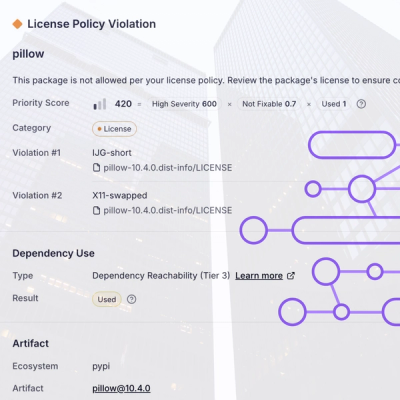
Research
/Security News
Critical Vulnerability in NestJS Devtools: Localhost RCE via Sandbox Escape
A flawed sandbox in @nestjs/devtools-integration lets attackers run code on your machine via CSRF, leading to full Remote Code Execution (RCE).
@serenity-js/playwright-test
Advanced tools
Serenity/JS test runner adapter for Playwright Test, combining Playwright's developer experience with the advanced reporting and automation capabilities of Serenity/JS
Serenity/JS is an innovative open-source framework designed to make acceptance and regression testing of complex software systems faster, more collaborative and easier to scale.
⭐️ Get started with Serenity/JS!
👋 Join the Serenity/JS Community!
@serenity-js/playwright-test module offers a Serenity/JS reporter
and fixtures that integrate Playwright Test with Serenity/JS Screenplay Pattern APIs.
Learn more about using Serenity/JS with Playwright Test
To install this module, use an existing Playwright Test project or generate a new one by running:
npm init playwright@latest
Install the below Serenity/JS modules in your Playwright Test project directory:
npm install --save-dev @serenity-js/assertions @serenity-js/console-reporter @serenity-js/core @serenity-js/serenity-bdd @serenity-js/web @serenity-js/playwright @serenity-js/playwright-test
To use Serenity/JS Screenplay Pattern APIs and benefit from the in-depth reporting capabilities, import Serenity/JS test fixtures instead of the default ones:
// example.spec.ts
+ import { test } from '@serenity-js/playwright-test'
- import { test } from '@playwright/test'
test.describe('Serenity Screenplay with Playwright', () => {
test.describe('New Todo', () => {
test('should allow me to add todo items', async ({ page }) => {
//...
})
})
})
If you prefer, Serenity/JS also offers the more concise BDD-style describe/it syntax:
// example.spec.ts
import { describe, it, test } from '@serenity-js/playwright-test'
test.use({
headless: true,
})
describe('Serenity Screenplay with Playwright', () => {
describe('New Todo', () => {
it('should allow me to add todo items', async ({ page }) => {
//...
})
})
})
Serenity/JS test fixtures simplify how you instantiate and use Serenity/JS Screenplay Pattern Actors.
If your tests need only a single actor, you can inject it using the actor fixture.
To configure the name of your default actor, use the defaultActorName configuration property:
// example.spec.ts
import { describe, it, test } from '@serenity-js/playwright-test' // import fixtures
import { Navigate, Page } from '@serenity-js/playwright' // import Screenplay Pattern web APIs
import { Ensure, equals } from '@serenity-js/assertions' // import Screenplay Pattern assertion APIs
test.use({
headless: true,
defaultActorName: 'Serena' // change default actor name
})
describe('Serenity Screenplay with Playwright', () => {
describe('New Todo', () => {
// inject default actor:
it('should allow me to add todo items', async ({ actor }) => {
// define test workflow
await actor.attemptsTo(
Navigate.to('https://todo-app.serenity-js.org/'),
Ensure.that(Page.current().title(), equals('Serenity/JS TodoApp')),
)
})
})
})
For multi-actor scenarios where you need each actor to use a separate browser, use the actorCalled fixture.
You can also use this pattern to override the default actor name on a per-scenario basis:
// example.spec.ts
import { describe, it, test } from '@serenity-js/playwright-test' // import fixtures
describe('Serenity Screenplay with Playwright', () => {
describe('Chat app', () => {
it('should allow actors to send and receive messages', async ({ actorCalled }) => {
// define part of the workflow performed by the first actor:
await actorCalled('Alice').attemptsTo(
// navigate to a chat app
// post a message to Bob
)
// define parts of the workflow performed by the any other actors:
await actorCalled('Bob').attemptsTo(
// navigate to a chat app
// post a reply to Alice
)
// Note that invoking actorCalled(name) multiple times
// while using the same name and within the scope of a single test
// returns the same actor, so you don't need to cache them:
await actorCalled('Alice').attemptsTo(
// check if the reply from Bob is received
)
})
})
})
The default cast of actors is limited to using a single ability
to BrowseTheWebWithPlaywright.
If you'd like to give your actors additional abilities, like to TakeNotes,
CallAnApi,
or ManageALocalServer, you can install the relevant Serenity/JS module
and configure them as follows:
// example.spec.ts
import { Cast, TakeNotes } from '@serenity-js/core'
import { test } from '@serenity-js/playwright-test'
import { BrowseTheWebWithPlaywright } from '@serenity-js/playwright'
import { CallAnApi } from '@serenity-js/rest'
test.use({
actors: async ({ browser, baseURL }, use) => {
await use(
Cast.where(actor => actor.whoCan(
BrowseTheWebWithPlaywright.using(browser),
TakeNotes.usingAnEmptyNotepad(),
CallAnApi.at(baseURL),
))
)
},
})
For scenarios where different actors need to be configured differently, you can also implement your own Cast:
// example.spec.ts
import { Cast } from '@serenity-js/core'
import { BrowseTheWebWithPlaywright, ExtraBrowserContextOptions } from '@serenity-js/playwright'
import { test } from '@serenity-js/playwright-test'
import { CallAnApi } from '@serenity-js/rest'
import { Browser, BrowserContextOptions } from 'playwright'
class Actors implements Cast {
constructor(
private readonly browser: Browser,
private readonly contextOptions: BrowserContextOptions,
private readonly extraContextOptions: ExtraBrowserContextOptions,
) {
}
prepare(actor: Actor) {
switch (actor.name) {
case 'James':
return actor.whoCan(BrowseTheWebWithPlaywright.using(this.browser, this.contextOptions, this.extraContextOptions))
default:
return actor.whoCan(CallAnApi.at(this.contextOptions.baseURL))
}
}
}
test.use({
actors: async ({ browser, config }) => {
await use(new Actors(browser, {
defaultNavigationWaitUntil: 'domcontentloaded'
}))
}
})
useFixtures lets you configure
Serenity/JS Screenplay Pattern actors in a single place,
and define custom test fixtures if needed.
// my-custom-api.ts
export const {
describe, it, test, beforeAll, beforeEach, afterEach, afterAll, expect
} = useFixtures<{ email: string }>({
// Override Serenity/JS fixtures:
actors: async ({ browser, baseURL }, use) => {
await use(
Cast.where(actor => actor.whoCan(
BrowseTheWebWithPlaywright.using(browser),
TakeNotes.usingAnEmptyNotepad(),
CallAnApi.at(baseURL),
))
)
},
// Add your own fixtures:
email: async ({ actor }, use) => {
await use(`${ actor.name }@example.org`);
},
})
With the custom test API definition in place, use it in your test files instead of the default one:
// example.spec.ts
import { Log } from '@serenity-js/core'
import { describe, it, test } from './my-custom-api' // Note the custom test API
describe('Serenity Screenplay with Playwright', () => {
describe('New Todo', () => {
// inject default actor:
it('should allow me to add todo items', async ({ actor, email }) => {
// define test workflow
await actor.attemptsTo(
Log.the(email),
)
})
})
})
You can use Serenity/JS and Playwright Test to write UI component tests and reuse your test code between component and end-to-end test suites.
To get started with component testing:
// src/App.spec.tsx
- import { test, expect } from '@playwright/experimental-ct-react'
+ import { test as componentTest } from '@playwright/experimental-ct-react'
+ import { useBase } from '@serenity-js/playwright-test'
+ const { test, expect } = useBase(componentTest)
import App from './App'
test.use({ viewport: { width: 500, height: 500 } })
test('should work', async ({ mount }) => {
const component = await mount(<App />)
await expect(component).toContainText('Learn React')
})
Serenity/JS useBase(test) creates
a test API that gives you access to all the SerenityFixtures
you could access in any other regular end-to-end test.
This capability allows you to use Serenity/JS Actors and design and experiment with your Screenplay Pattern Tasks before incorporating them in your high-level acceptance and end-to-end tests.
import { test as componentTest } from '@playwright/experimental-ct-react'
import { Ensure, contain } from '@serenity-js/assertions'
import { useBase } from '@serenity-js/playwright-test'
import { Enter, PageElement, CssClasses } from '@serenity-js/web'
import EmailInput from './EmailInput'
const { it, describe } = useBase(componentTest).useFixtures<{ emailAddress: string }>({
emailAddress: ({ actor }, use) => {
use(`${ actor.name }@example.org`)
}
})
describe('EmailInput', () => {
it('allows valid email addresses', async ({ actor, mount, emailAddress }) => {
const nativeComponent = await mount(<EmailInput/>)
const component = PageElement.from(nativeComponent)
await actor.attemptsTo(
Enter.theValue(emailAddress).into(component),
Ensure.that(CssClasses.of(component), contain('valid')),
)
})
})
To use Serenity/JS reporting capabilities, register the @serenity-js/playwright-test reporter in your
playwright.config.ts and define the appropriate reporting services (a.k.a. your "stage crew").
For example, to enable Serenity/JS Console Reporter and Serenity BDD Reporter, install the relevant modules:
npm install --save-dev @serenity-js/console-reporter @serenity-js/serenity-bdd
Next, configure your Playwright project as follows:
// playwright.conf.ts
import type { PlaywrightTestConfig } from '@playwright/test'
const config: PlaywrightTestConfig = {
testDir: './spec',
reporter: [
[ '@serenity-js/playwright-test', {
crew: [
'@serenity-js/console-reporter',
[ '@serenity-js/serenity-bdd', { specDirectory: './spec' } ],
[ '@serenity-js/core:ArtifactArchiver', { outputDirectory: 'target/site/serenity' } ],
// '@serenity-js/core:StreamReporter',
]
}],
// optional
[ 'html', { open: 'never' } ], // built-in Playwright HTML reporter
],
// Other configuration omitted for brevity
// For details, see https://playwright.dev/docs/test-configuration
}
export default config
Note that Serenity/JS reporters work well with the built-in Playwright reporters.
You can find a reference implementation demonstrating how to integrate Serenity/JS with Playwright Test in the Serenity/JS GitHub repository.
New features, tutorials, and demos are coming soon! Follow Serenity/JS on LinkedIn, subscribe to Serenity/JS channel on YouTube and join the Serenity/JS Community Chat to stay up to date! Please also make sure to star ⭐️ Serenity/JS on GitHub to help others discover the framework!
If you appreciate all the effort that goes into making sophisticated tools easy to work with, please support our work and become a Serenity/JS GitHub Sponsor today!
FAQs
Serenity/JS test runner adapter for Playwright Test, combining Playwright's developer experience with the advanced reporting and automation capabilities of Serenity/JS
The npm package @serenity-js/playwright-test receives a total of 4,033 weekly downloads. As such, @serenity-js/playwright-test popularity was classified as popular.
We found that @serenity-js/playwright-test demonstrated a healthy version release cadence and project activity because the last version was released less than a year ago. It has 1 open source maintainer collaborating on the project.
Did you know?

Socket for GitHub automatically highlights issues in each pull request and monitors the health of all your open source dependencies. Discover the contents of your packages and block harmful activity before you install or update your dependencies.

Research
/Security News
A flawed sandbox in @nestjs/devtools-integration lets attackers run code on your machine via CSRF, leading to full Remote Code Execution (RCE).

Product
Customize license detection with Socket’s new license overlays: gain control, reduce noise, and handle edge cases with precision.

Product
Socket now supports Rust and Cargo, offering package search for all users and experimental SBOM generation for enterprise projects.